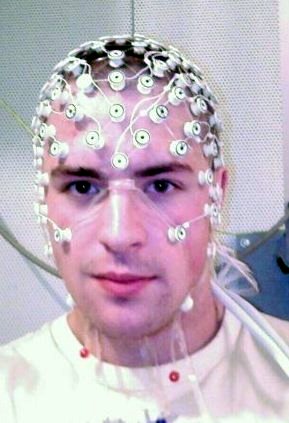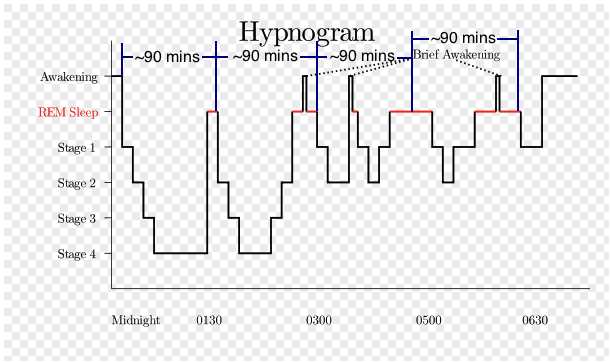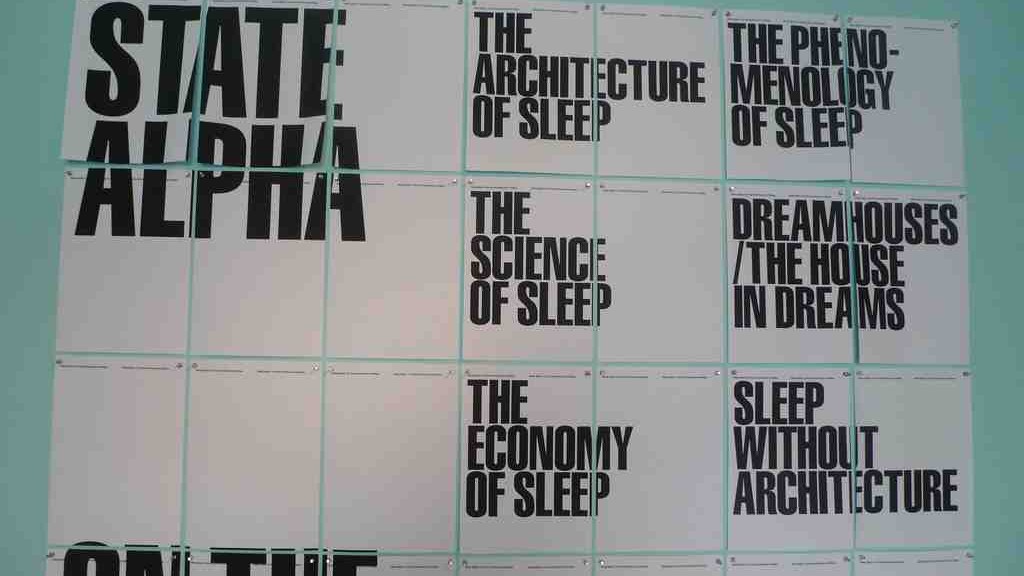Featured image courtesy of Regine Debatty.
Introduction:
What is sleep? As human beings, we all obviously have some intuitive understanding that we get tired and get the urge to sleep with some regularity, and after sleeping we (generally) feel recharged. As I mentioned in the first part of this series, however, not all sleep is created equal.
There are numerous factors at play in defining sleep quality, and quality sleep is exactly what you need to be at your best, not just a certain quantity (although there is also that).
While sleeping, different physiological phenomena occur at different times to bring about the full recovery necessary for our continued existence. Scientists are still hypothesizing as to what exactly occurs during sleep and why it is so critical, but a lot of insight has already been inferred from experimental and observational data. Armed with these observations, we can learn to increase the quality of our sleep to get the rest we need. To begin, we’ll look at what scientists have discovered about what happens during sleep and their current state of conclusions so we can effectively define sleep quality. First up – let’s look at the structure of sleep, which is known as sleep architecture.
Sleep Architecture:
To measure brain activity, scientists use electroencephalography (EEG). EEG measures electrical currents in the brain by placing electrodes along the scalp. This gives a glimpse into the actions of the brain’s neurons by measuring brain waves, which are the brain’s electrical output.

During EEG studies on peoples’ brains while they sleep, it was determined that the brain’s electrical output varies cyclically throughout the night. These cycles are approximately 90 minutes in length, although that timing varies by individual and has been measured anywhere from 80-120 minutes. In a typical night of 7-8 hours of sleep, an individual is likely experiencing 4-5 complete cycles. Within each cycle, there are distinct stages. The stages are classified as either rapid-eye-movement sleep (REM sleep) or non-rapid-eye-movement sleep (NREM sleep). Quite literally, REM sleep means that the subject’s eyes are moving rapidly while closed, and NREM sleep means that the subject’s eyes either don’t move or move very slowly. NREM sleep is further broken down into either three or four separate cycles depending on which sleep scientist you ask. In 2008, most sleep scientists decided that stage 3 and stage 4 sleep were essentially the same thing (known as slow-wave sleep), and the stages were thus combined into one, hence the discrepancy.
In a typical cycle, the sleeper begins sleep in NREM stage 1, then spends some time in each consecutive NREM stage before jumping to REM for a time and then restarting the cycle. These cycles change throughout the night. Plotting the time spent in each stage of sleep throughout the night produces a plot known as a hypnogram, which describes the structure of sleep, and is thus known as sleep architecture. An example of a hypnogram is shown below:

The sleep cycles change throughout the night. In the example above, which is known to be a typically healthy hypnogram, most of the NREM stage 3/4 sleep (slow-wave sleep) is in the first two cycles, while most of the REM sleep is in the last two cycles. The last two cycles also have brief periods of awakening between the onset of a new cycle. Thus, waking up in the night between cycles is perfectly natural; there is nothing wrong with you if that occurs and there is no problem so long as you can get back to sleep fairly quickly (an old problem of mine that I have solved through understanding this process). Now let’s take a look at each stage individually.
The Sleep Stages Explained:
In truth, as mentioned in the introduction, there is still a lot of mystery and controversy over the role of each sleep stage, and of sleep in general. That being said, there have been some illuminating observations.
NREM Stage 1 Sleep:
Stage 1 sleep is a very light state of sleeping, so the sleeper is very easily awoken from external stimulus. When awoken from stage 1 sleep, the sleeper is rarely aware that he/she was even unconscious. Stage 1 sleep is also when the ‘hypnic jerk’ phenomenon can be experienced by the sleeper which is described as a sudden jolt or falling sensation before the sleeper slips into the deeper stages of sleep.
Also in this stage, EEG readings show the brain moving from “alpha waves” to “theta waves”, which basically means that brain activity slows down. However, there is no consensus on the exact purpose of stage 1 sleep. It is generally hypothesized that stage 1 sleep is only meant as a transitionary stage between wakefulness and deeper stages of sleep.
NREM Stage 2 Sleep:
Stage 2 sleep represents 45-55% of total sleep time in healthy adults. It is characterized by a loss of conscious awareness of the external environment, decreased muscle tone and a lowering of body temperature. During stage 2 sleep, EEG readings show theta waves as the predominant brain wave, but these theta waves are interrupted by K-complexes and sleep spindles.
The purpose of stage 2 sleep is, similarly to stage 1, not entirely clear, although there are certain common hypotheses amongst sleep scientists. There is mounting evidence that stage 2 sleep is important for the process of memory consolidation through sleep spindle activity. The K-complexes have been thought to be forerunners to the brain activity in stage 3/4 sleep (slow-wave sleep, see below), which I know sounds a bit weak. Sleep science is still developing and many mysteries still remain.
NREM Stage 3 Sleep – Slow-wave Sleep
As mentioned above, stage 3 sleep is now considered to have replaced the historic stage 3/4 sleep. It is characterized by the brain’s electrical output as measured by EEG being delta waves that are relatively quite low in frequency (hence slow-wave sleep). It is during this stage that the sleeper is very unresponsive to the surrounding environment, and if the sleeper is awoken during this stage they will experience intense grogginess and disorientation. Sleepwalking, bed-wetting, and night terrors are experienced by some sleepers during stage 3 sleep. This stage of sleep is considered to be critically important to the regenerative properties of sleep. The relatively high proportion of stage 3 sleep in the early part of the night (see figure above) is thought to be evidence of its priority in the sleeping process.
Stage 3 sleep is thought to be the most physically restorative sleep, and is the time when human growth hormone (HGH) is naturally released by the brain. Extremely intense exercise increases the amount of slow-wave sleep experienced by the sleeper by swapping out stage 2 sleep, which lends more support to the theory that stage 3 sleep is a priority. Further evidence comes from sleep deprivation studies where, in one study, the amplitude of stage 3 sleep was much higher during recovery from a 24-hour wakeful period. This means that there is an intensity gradient to stage 3 sleep, meaning that it can vary in exactly how deep it is as measured by the size (amplitude) of the delta waves.
I can certainly relate to these findings. I definitely have noticed that if I don’t get any intense exercise for several days that my sleep becomes lighter and less restful. Ironically, I find that getting enough intense exercise leads to greater energy levels on average because the quality of my sleep is improved.
Rapid-Eye-Movement (REM) Sleep:
As is obvious from the name of this stage of sleep, REM sleep is characterized by the sleeper’s eyes moving rapidly beneath closed eyelids, and account for about 20-25% of total sleep time in normal adults. As seen in the hypnogram above, the length of time spent in REM sleep increases throughout the night with each progressive sleep cycle, so most of it is experienced closer to morning. Brain activity is actually very high during REM sleep, and is sometimes higher than when the same subject is awake, although it is very difficult to rouse a sleeper while they are in REM sleep. This is why REM sleep is also known as “paradoxical sleep”. Most muscles are paralyzed during REM sleep.
REM sleep is considered to be the most mentally restorative sleep, and is the stage that produces the most memorable dreams. After sleep deprivation, sleepers will spend more time in REM sleep upon recovery sleep (the REM ‘rebound effect’) at the expense of the lighter stages (stages 1 and 2), which provides evidence that it is also a priority. Infants spend a much larger proportion of their sleeping time in REM sleep, which is when the brain is developing. REM sleep is considered to be critical for the consolidation of certain types of memory (spatial and procedural), and is also strongly associated with problem solving and creativity.
Sleep Quality Defined:
‘Sleep quality’ is inherently somewhat subjective. As I mentioned in Part 1 , what really matters is how you feel when waking up and your energy levels throughout the day. However, with knowledge of the different sleep stages, sleep quality can be defined more objectively. Based on the evidence of known studies, sleep quality can be more objectively defined as going through the required amount of sleep cycles and experiencing the proper amount of each stage, especially NREM stage 3 (slow-wave) sleep and REM sleep.
A restless night of flittering about in stage 1 and 2 sleep will leave you feeling ragged and exhausted, and getting more stage 1 and 2 sleep will not improve your alertness levels. You will not perform at your peak without sufficient stage 3 and REM sleep… period. There are numerous factors at play which determine whether a sleeper will experience the correct number of cycles and the correct amount of each stage within each individual cycle (recall that the cycles change from stage 3 dominant to REM dominant throughout the night). These factors will be the subject of the remainder of the posts within this series.
First up will be two posts looking at the main hormones at play in determining sleep quality. After that, there will be a post on how different ingested substances affect sleep quality. Finally, there will be a post on how to optimize sleep based on what was learned and then a post on coping with subpar sleep when you need to.
Thank you for reading! Please comment below if you have any thoughts or questions.
G

Hi there, Graham nice article. I just finished the part 1 and will to read the rest later. In my own experience waking up once or many times at night is mostly related to our thinking, planning, worries, stress, anxiety or happiness…just to mention few. Our brain is a very complicated network system. I work hard and excercise when I have time. I try to eat whole foods and healthy, but I take some supplements like adaptogens, Mucuna, L- Tryptophan… I try to get more daylight as I can in order to stimulate serotonin’s production. I want to add that sleep quality is related to to some other things like noise, room temperature and darkness, bedding (mattress, pillow).
Hi R.M.,
Thanks for the comment! I agree about the waking up in the night. When I’m of calm mind, it doesn’t really happen. That said, it usually is between cycles, and there is a historical precedent for middle of the night awakenings, and some people can just make these a part of their routine as opposed to stressing about them.
Here’s a good intro to the historical precendent: http://slumberwise.com/science/your-ancestors-didnt-sleep-like-you/
Thanks for the additions! Noise, room temp, darkness, bedding – all critical. I’m considering a follow up article to address these points.
Thanks again! I really appreciate valuable contributions like yours.
Graham
Hi Graham, you are welcome. Thank you for the link. I would like to mention another point which I’m sure you know about it, but is good to remind the readers.
Eating Tryptophan foods does not ensure 100% that our body will synthesis Serotonin. One reason is because Tryptophan foods usually contain other amino acids, that will compete with tryptophan to cross the brain blood barrier (BBB). In this case tryptophan mostly lose. Paradoxically, eating protein rich foods will decrease Serotonin, so it is important to eat carbohydrate foods without any protein rich foods during the day to release insulin and absorb the competitive amino acids. L-Tryptophan as a supplement won’t compete and can directly cross the BBB.
Another thing it is important to ensure eating Serotonin co-factors foods (vitamin b3, 6, 9, 12, vit c and d, iron, zinc, magnesium, calcium,selenium, in order to our body synthesis Serotonin including Melatonin which needs vit b5.
I make one smoothie with those cofactors (sunflower seeds, spinach…) plus 3 L-tryptophan capsules and 1 or 2 Ginkgo Biloba capsules every other week and Dopamine smoothie with Mucuna (l-dopa) with its cofactors every other week as well.
Best regards
R.M.
That’s valuable information. Thank you for the comment!
Graham
“waking up in the night between cycles is perfectly natural; there is nothing wrong with you if that occurs and there is no problem so long as you can get back to sleep fairly quickly (an old problem of mine that I have solved…”)
Great article. Regarding your quote above was there a specific “thing” (method, nutrient, etc.) that helped you resolve this problem?
I currently wake up every night between the 2nd and 3rd cycle (3:00 am/3:30 am) and have a hard time getting back to sleep…most times I just get up.
Thanks,
Hi Johnny,
Thanks for the comment and question. There was no specific nutrient that helped me with this problem. Generally speaking, I just learned not to stress about it as it was natural, and tried to enjoy a bit of middle-of-the-night awake time, and eventually just started falling back asleep quickly when it happened. Also, some basic meditation breathing exercises can help too (deep breaths, focus on nothing but the breath, let the thoughts pass through without attaching yourself to them…).
Truth be told – it still happens sometimes where I struggle to get back to sleep, and generally speaking (not always), there is something on my mind that wakes me up in between cycles and gets me stimulated. That can be many things. Once I’ve resolved what’s been stressing me/stimulating me, I usually start sleeping through the night again. There is sometimes a challenge in determining what it is that’s bothering me as it’s not always obvious, but usually brutal honesty with myself can help shed light on what it is, and then I can start taking actions to resolve it.
I hope that helps. The majority of the time, sleep issues like this go away on their own when the cause (which can be many things) goes away.
Why not take that time at 3 am to ask yourself, “What’s up? What’s on your mind?”.
That might not apply to you, but it certainly does to me.
Also, and I assumed this wasn’t the case for you – avoid alcohol before bed. It can cause mid-night awakenings when the effects wear off. At the very least, it’ll make it worse.
Cheers,
Graham